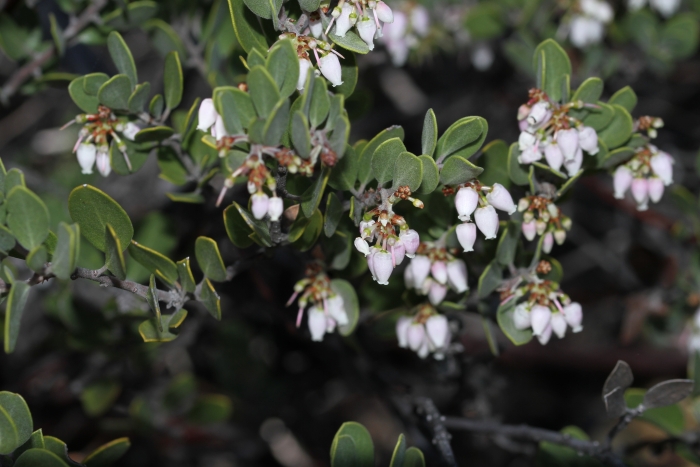Mount Tamalpais Manzanita
(Arctostaphylos montana)
Mount Tamalpais Manzanita (Arctostaphylos montana)
/
/

Nicholas Wei
CC BY-SA 4.0
Image By:
Nicholas Wei
Recorded By:
Copyright:
CC BY-SA 4.0
Copyright Notice:
Photo by: Nicholas Wei | License Type: CC BY-SA 4.0 | License URL: http://creativecommons.org/licenses/by-sa/4.0/ | Rights Holder: Nicholas Wei | Publisher: iNaturalist | Date Created: 2022-03-26T12:17:10-07:00 |

























Estimated Native Range
Summary
Arctostaphylos montana, commonly known as Mount Tamalpais manzanita, is an evergreen shrub native to the chaparral and scrub habitats of Mount Tamalpais and the coastal bluffs of the Presidio of San Francisco. This species, including its two subspecies, was formerly classified under Hooker’s manzanita but has since been recognized as distinct. Arctostaphylos montana typically grows to 2-6 feet in height and width, with a dense, rounded form. It features smooth red bark and stiff, twisting branches. The foliage is comprised of small, leathery leaves that are green to gray-green in color. The plant blooms in late winter to early spring, producing clusters of small, urn-shaped, white to pale pink flowers that are quite showy and attract pollinators. Following flowering, it bears red berries that are a food source for local wildlife.
Mount Tamalpais manzanita is valued for its attractive bark, evergreen foliage, and showy flowers. It is used in native plant gardens, as an ornamental shrub in residential landscaping, and for habitat restoration projects. It thrives in well-drained soils, requires little water once established, and prefers full sun to partial shade. While generally low maintenance, it can be susceptible to fungal diseases such as Phytophthora root rot if conditions are too wet. Gardeners should avoid overwatering and ensure proper soil drainage to prevent issues. This species is not known for aggressive roots or significant disease problems, but it can be sensitive to over-irrigation and poor drainage.CC BY-SA 4.0
Mount Tamalpais manzanita is valued for its attractive bark, evergreen foliage, and showy flowers. It is used in native plant gardens, as an ornamental shrub in residential landscaping, and for habitat restoration projects. It thrives in well-drained soils, requires little water once established, and prefers full sun to partial shade. While generally low maintenance, it can be susceptible to fungal diseases such as Phytophthora root rot if conditions are too wet. Gardeners should avoid overwatering and ensure proper soil drainage to prevent issues. This species is not known for aggressive roots or significant disease problems, but it can be sensitive to over-irrigation and poor drainage.CC BY-SA 4.0
Plant Description
- Plant Type: Shrub
- Height: 3-6 feet
- Width: 3-6 feet
- Growth Rate: Moderate
- Flower Color: White, Pink
- Flowering Season: Spring
- Leaf Retention: Evergreen
Growth Requirements
- Sun: Full Sun, Part Shade
- Water: Low
- Drainage: Medium, Fast
Common Uses
Bee Garden, Bird Garden, Drought Tolerant, Hummingbird Garden, Low Maintenance, Rock Garden
Natural Habitat
Chaparral and scrub habitats of Mount Tamalpais and the coastal bluffs of the Presidio of San Francisco
Other Names
Common Names: Mountain Manzanita, Bearberry
Scientific Names: , Arctostaphylos montana, Arctostaphylos hookeri subsp. montana, Arctostaphylos pungens subsp. montana, Arctostaphylos pungens var. montana, Uva-ursi montana,
GBIF Accepted Name: